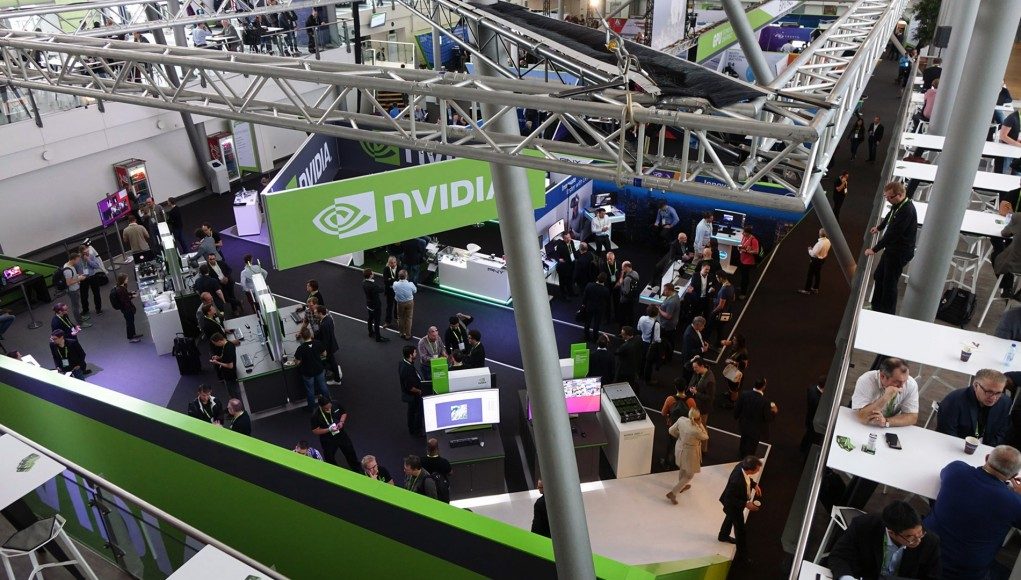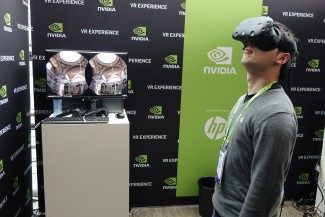At GTC Europe in Amsterdam last month, NVIDIA’s ‘VR Village’ was host to a number of cutting-edge virtual reality demos, many of which we’ve had our hands on before. But there was something new being shown behind closed doors.
No cameras were permitted inside the booth, nor am I at liberty to say which brand was involved. Having no idea what to expect, I donned a Vive headset, and found myself in a typical 3D modelling environment (a grey void), standing next to a model of a popular four-door family sedan.
At first glance, there was nothing out of the ordinary here. Standing at arm’s reach from the side of the car, the model was obviously accurate, but being untextured, with no realistic material shaders or fancy lighting effects, it looked fairly bland. I was instructed to get close to the driver’s side window and peer in, and it became apparent that this was modelled to an unusually high level of detail. But only when I switched to the driver’s seat were the true capabilities of this model revealed.
 Leaning around the steering wheel, I start to admire the control stalks, with their white markings for indicators and wipers. These markings, barely a millimetre across, are not textures, but a raised surface made from polygons. Before I have time to process this, the ‘clipping sphere’ has been activated. This creates invisible spheres around the motion controllers which effortlessly cut through the vehicle’s geometry. My jaw is immediately on the floor—this isn’t an empty shell; every layer of material is modelled. Clipping slowly through the centre of the steering wheel, I’m peeling away layers of plastic and metal, revealing the full complexity of the airbag system. The level of detail is ridiculous.
Leaning around the steering wheel, I start to admire the control stalks, with their white markings for indicators and wipers. These markings, barely a millimetre across, are not textures, but a raised surface made from polygons. Before I have time to process this, the ‘clipping sphere’ has been activated. This creates invisible spheres around the motion controllers which effortlessly cut through the vehicle’s geometry. My jaw is immediately on the floor—this isn’t an empty shell; every layer of material is modelled. Clipping slowly through the centre of the steering wheel, I’m peeling away layers of plastic and metal, revealing the full complexity of the airbag system. The level of detail is ridiculous.
Next, the whole model is scaled up and I’m standing inside the brake system, followed by the engine bay. Every component is here, not just on the surface, but all of it. This isn’t the first time the concept of clipping through a car model has been successful—Audi embrace it as a feature of their VR showroom—but this is on a whole new level, made for analysing full CAD data with sub-millimetre precision.
A freeform travel mode allows full exploration, operated with one motion controller, controlling direction of movement with tilt, and speed with the analogue trigger. This is actually an interesting locomotion solution in itself, minimising motion sickness due to the tight user control. I fly through the ventilation system, and into a speaker grille. Every hole in the mesh is circular, with no obvious polygon angles. A few micro layers deeper, I find a hidden Bose logo on the speaker cone. Next, I’m staring in disbelief at the stitching on the seats. Each stitch is smooth and curved, which I assume must be due to tessellation but no, I’m told no on-the-fly tessellation was used. The stitching for a single seat has around 1.4 million triangles; a single stitch loop has around 180 triangles.
I look at the seat belt connector, which contains the complex clip and release mechanism then head towards the rear view mirror, and peel back the layers. Inside is a small cable connection, and of course, a tiny serial number stamped into the plastic. I could’ve spent hours in this car, marvelling at every detail.
At this point, I’m shown how elements can be sorted by material, for instance, just the rubber. A vast number of rubber pieces are found throughout a car, from tiny gaskets and intricate cabling to bigger elements like the door and window seals, and the spare tyre. Then, the plastics. Turns out modern cars are full of the stuff. Finally I’m shown Explosion Mode, where each part moves in one of 6 directions, showing the vast number of objects the car is composed of, and to demonstrate that every object can not only be rendered, but also animated.
Quite simply, it’s the most detailed car model I’ve ever seen. For some perspective, the stunning models found in games such as Driveclub, Project CARS, Gran Turismo and Forza Motorsport tend to have anywhere between 250,000 and 1 million polygons. The model on display here had 67.2 million, according to the creators. And, unlike many other industry-orientated demos of high-quality models, there were no framerate issues, running at a rock-solid 90 FPS, with 4x supersampling and 2xMSAA. Needless to say, it was running on a ultra high-performance PC with a pair of Nvidia’s Quadro P6000 GPUs. The new Pascal-based flagship Quadro cards are now available through PNY, with OEM systems coming later in the year.
But even with the most powerful GPUs on tap, it required a new approach to culling explains Dave Weinstein, Director of Professional Virtual Reality at Nvidia.
“Nvidia built a proprietary reference OpenGL-based render pipeline. To make simultaneous use of both P6000s, it incorporates VR SLI (through the GL_NV_GPU_multicast extension), a component of the NVIDIA VRWorks SDK. The rendering is done through command lists (using the GL_NV_command_list extension), which are generated by an on-GPU culling algorithm,” he said. “This technique allows us to cull and render without a readback to the CPU. Combining VR SLI and culling with command lists actually results in both GPUs rendering a slightly different scene, since each GPU culls for its own view.”
This technology will undoubtedly play a big role in the future of industrial design and engineering. Once embraced by the manufacturing industries, this level of interactivity should be straightforward to implement. Indeed, the confidential CAD data supplied for this project arrived as a polygon model in VRED-compatible format, and converting the data to Nvidia’s format was an “easy, automated task,” I’m told. Being able to reference and study a complex model in VR with such detail, ease, and comfort is truly compelling, and makes a strong case for professional graphics performance in engineering environments.
Disclosure: Nvidia paid for accommodation for one Road to VR correspondent to attend an event where information for this article was gathered.








